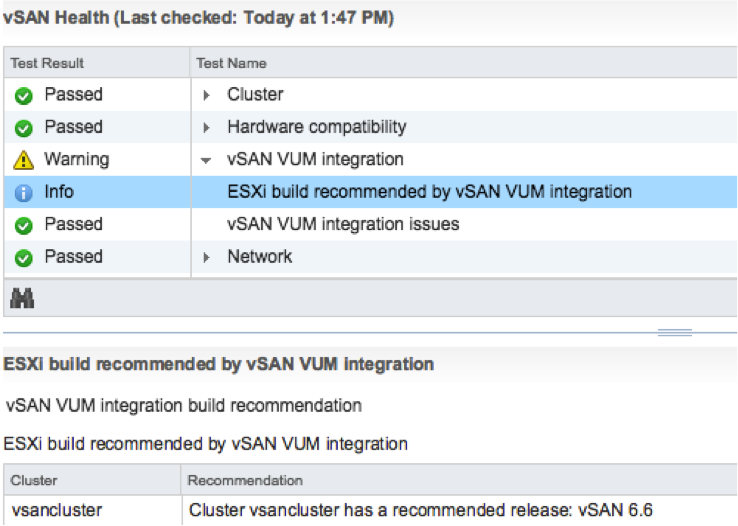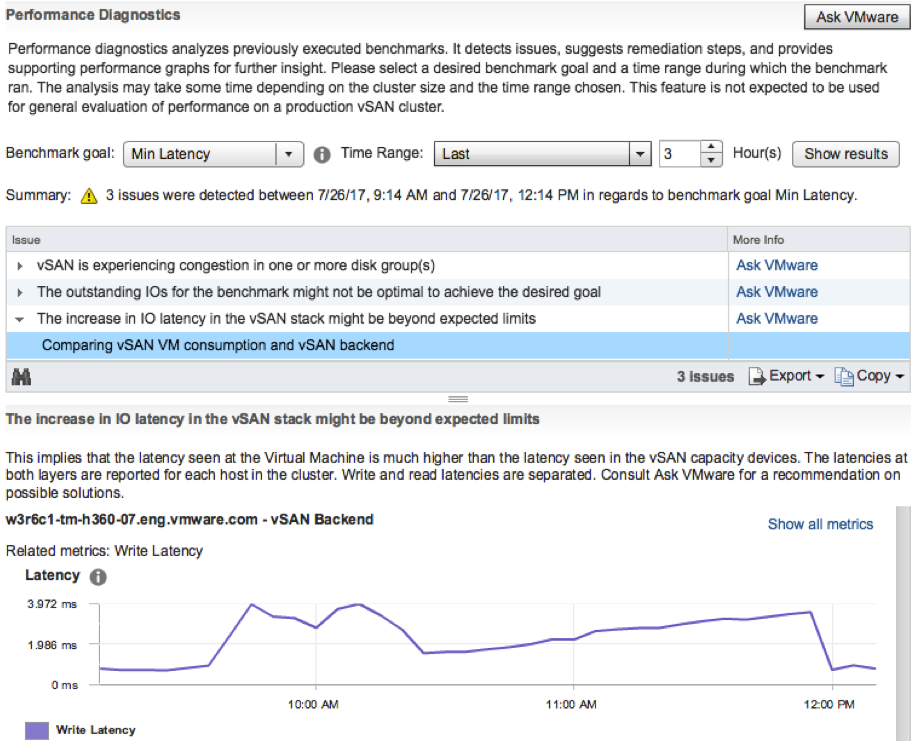vSphere 6.5 U1 was released last night. It has some cool new functionality in there as part of vSAN 6.6.1 (I can’t wait for vSAN 6.6.6 to ship ;-)). There are a lot of fixes of course in 6.6.1 and U1, but as stated, there’s also new functionality:
- VMware vSphere Update Manager (VUM) integration
- Storage Device Serviceability enhancement
- Performance Diagnostics in vSAN
So those using vSAN 6.2 who upgraded to vSphere 6.0 U3, here’s your chance to upgrade to get all vSAN 6.5 functionality, and more!
The VUM integration is pretty cool if you ask me. First of all, when there’s a new release the Health Check will call it out from now on. And on top of that, when you go to VUM then also things like async drivers will be taken in to consideration. Where you would normally have to slipstream drivers in to the image and make that image available through VUM, we now ensure that the image used is vSAN Ready! In other words, as of vSphere 6.5 U1 Update Manager is fully aware of vSAN and integrated as well. We are working hard to bring all vSAN Ready Node vendors on-board. (With Dell, Supermicro, Fujitsu and Lenovo leading the pack.)

Then there’s this feature called “Storage Device Serviceability enhancement”. Well this is the ability to blink the LEDs on specific devices. As far as I know, in this release we added support for HP Gen 9 controllers.
And last but not least: Performance Diagnostics in vSAN. I really like this feature. Note that this is all about analyzing benchmarks. It is not (yet?) about analyzing steady state. So in this case you run your benchmark, preferably using HCIBench, and then analyze it by selecting a specific goal. Performance will be analyzed using “cloud analytics”, and at the end you will get various recommendations and/or explanations for the results you’ve witnessed. These will point back to KBs, which in certain cases will give you hints how to solve your (if there is) bottleneck.

Note that in order to use this functionality you need to join CEIP (Customer Experience Improvement Program), which means that you will upload info in to VMware. But this by itself is very valuable as it allows our developers to solve bugs / user experience issues and getting a better understanding of how you use vSAN. I spoke with Christian Dickmann on this topic yesterday as he tweeted the below, and he was really excited, he said he had various fixes going in the next vSAN release based on the current data set. So join the program!
A huge THANK YOU to anyone participating in Customer Experience Improvement Program (CEIP)! Eye-opening data that we are acting on.
— Christian Dickmann (@cdickmann) July 27, 2017
For those how can’t wait, here’s the release notes and downloads links:
- vCenter Server 6.5 u1 release notes: https://docs.vmware.com/en/VMware-vSphere/6.5/rn/vsphere-vcenter-server-651-release-notes.html
- vCenter Server 6.5 u1 downloads: https://my.vmware.com/web/vmware/details?downloadGroup=VC65U1&productId=614&rPId=17343
- ESXi 6.5 release notes: https://docs.vmware.com/en/VMware-vSphere/6.5/rn/vsphere-esxi-651-release-notes.html
- ESXi 6.5 download: https://my.vmware.com/web/vmware/details?downloadGroup=ESXI65U1&productId=614&rPId=17342
- vSAN 6.6.1 release notes: https://docs.vmware.com/en/VMware-vSphere/6.5/rn/vmware-vsan-661-release-notes.html
Oh and before I forget, there’s new functionality in the H5 Client for vCenter in 6.5 U1. As mentioned on this vSphere blog: “Virtual Distributed Switch (VDS) management, datastore management, and host configuration are areas that have seen a big increase in functionality”. And then some of the “max config” items had a big jump. 50k powered on VMs for instance is huge:
- Maximum vCenter Servers per vSphere Domain: 15 (increased from 10)
- Maximum ESXi Hosts per vSphere Domain: 5000 (increased from 4000)
- Maximum Powered On VMs per vSphere Domain: 50,000 (increased from 30,000)
- Maximum Registered VMs per vSphere Domain: 70,000 (increased from 50,000)
That was it for now!
I was just about to finisch a vSAN 6.6 design. Will update the design accordingly.
It still amazes me that VMware is stuck in the 90’s with storage. vSAN is WAY too expensieve for the SMB crowd. Why not implement Linux MD or ZFS or GFS? Because VMware can sell EMC and Dell storage products… That’s why.
Meanwhile Xen, bhyve and ProxMox have storage as part of the base package…
Official CEPH support is needed!!!!!!!!1